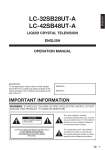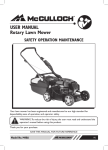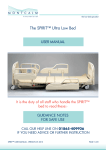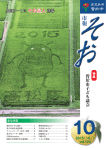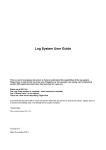Download Hog Slat® Gestation Stall Installation Manual
Transcript
Gestation Stall Manual Identification of Stall Components 209’ 3’ 3’ 100’ 41’ 50) 24” stalls 3’ 100’ ILLUSTRATION 1A Feeding Alley 3’ Feeding alley Our example building has eight rows of 50 3 stalls that are 24” wide. The length of the ILLUSTRATION 1A is planare of three a typical building is 209’ IDfloor and there alley-gestation 7 building that serve an example of the ways 36”will wide. Theas width of the building is installaID. Therestalls are two 36”feeding lotion of41’ gestation through out alleys this manual. Our2 cated along the outside and another 36” alley example building has eight rows of 50 stalls that are down the middle. In addition there are two 7 24” x 24” 7’0”access long.alleys The length ofthe theback building located at of the is 209’ ID (ID stands Dimension) and there are three3 stalls for overInside the slats. alleyways 36” wide. The width of the building is 41’ 7 ID. There are two 36”feeding alleys located along the 2 outside and another 36” alley down the middle. In addition there are two 24” access alleys located at the 7 back of the stalls over the slats. ILLUSTRATION 1B and 1C are close-ups of top and side views. 3 7’ 2’ Access alley Access Alley 7’ Feeding alley Feeding Alley 3’ 7’ Access 2’ alley Access Alley 7’ Feeding alley 3’ Feeding Alley ILLUSTRATION 1B 3’ Feeding Alley 3’ Feeding Alley 2’ Access 2’ Alley Access 3’ Feeding Alley 3’ Feeding Alley Alley 2’ Access Alley 2’ Access Alley 7’ 7’ 7’ 7’ 3’ Feeding 3’ Feeding Alley 7’ Alley 7’ 7’ 7’ ILLUSTRATION 1C Slats Slats 1 Slats Slats Identification of Stall Components Slope Front/A.I. Back Slope Front/Slope Back Slope Front/Straight Back Slope Front/Modified A.I. Back Straight/A.I. Back Straight Front/Slope Back Straight Front/Straight Back Straight Front/Modified A.I. Back STALLS SIDES ILLUSTRATION 2A 2 Floor Spacer (23” Centers) Floor Spacer (24” Centers) Floor Spacer (26” Centers) FLOOR SPACER ILLUSTRATION 3A Front Door Front Door Rear Door Rear Door (w/ pipe) (w/ pipe) ILLUSTRATION 3C ILLUSTRATION 3B SHORT DOOR GATE ROD LONG DOOR GATE ROD ILLUSTRATION 3D 3 PART # 5000100100 24 5/8” below bend PART # 1000100100 ILLUSTRATION 3E 19 3/4” below bend Top Spacer (23” Centers) Top Spacer (24” Centers) Top Spacer (26” Centers) TOP SPACER ILLUSTRATION 4A 1/4” V-BOLT PART # 60647 Gestation Top Spacer Connectors PART # 5000920100 ILLUSTRATION 4B ILLUSTRATION 4C CAST T-BOLT PART # 309045100 1) 3090700000 CAST IRON TEE ONLY 1) 60831 SS BOLT 1/2” X 4 1/2” 1) 60583 1/2” SS FLAT WASHER ILLUSTRATION 4E 1/4” locknut PART # 60680 ILLUSTRATION 4D STAINLESS STEEL T-BOLT PART # 3090100500 S.S. T-BOLT 1) 3090441500 1/2” x 5 1/2” Stainless STEEL T-BOLT 1) 60583 SS FLAT WASHER 1) 60693 ss LOCK NUT ILLUSTRATION 4F 4 A) Preparation of Barn ILLUSTRATION 5A The is first is to measure the building to verify its inside dimensions.If the If the building The first step tostep measure the building to verify its inside dimensions. building is the different expected, may be able to alleys to the buildILLUSTRATION measurement 5A represents samethan building as in you ILLUSTRATION 1Aadjust . The the firstwidth step of is the measure measurement is different than expected, you may be able to adjust the width of thetoalleys to compensate. ing to verify its inside dimensions. If the building measurement is different than expected, you may be able to ad- compensate. just the width of the alleys to compensate. B) Layout of Stalls The first step is to measure the building to verify its inside dimensions. If the building measurement is different than expected, you may be able to adjust the width of the alleys to compensate. NOTE: CORRECT LOCATION OF FLOOR SPACERS IS BEHIND STALL LEG A A A A ILLUSTRATION 5B B B in place laying out the correct alleyway widths across the building Position two stall sides width.. Position After two thestalls position of the stalls determined, mark the location of the front legs from the outside walls. sides in place laying out theis correct alleyway widths across the building Position two stalls sides in place laying out the correct alleyway widths thenecessary building to mark B width.. After the position the stalls is determined, markAthe location of the front from the These measurements areofrepresented by the and B arrows inlegs ILLUSTRATION 5B.across It is not width.. After position ofbythe stalls determined, mark outside walls. These measurements are represented A and Bis arrows in the drawing. It is the location of the front legs from the the back legs. Repeat on the the opposite side ofthethe building. B (see p.2 ILLUSTRATION 2A) not necessaryoutside to mark the back legs. Repeat on the opposite sideare of the building. walls. These measurements represented by the A and B arrows in the drawing. It is Position two stalls sides in place laying out the correct alleyway widths across the building not necessary to mark the back legs. Repeat on the opposite side of the building. 3’ end alley width.. After the position of the stalls is determined, mark the location of the front legs from the outside walls. These measurements are represented by the A and B arrows in the drawing. It is 3’ end alley Measure the desired end alley not necessary to mark the back legs. Repeat on the opposite side of the building. from the end wall of the buildA ing. Starting from this location, Chalk lines 3’ end alley B B A Chalk lines A A 5 B Chalk lines B Chalk lines ILLUSTRATION 5C B Chalk lines A Measure theB point desired mark the A and down end alley from the end wall of the Measure the desired the length ofStarting the building.from Us- this location, building. mark the Aend andalley B point ing a chalk line, establish a line from the end wall of the builddown the length of the building. Using a chalk line, establish down the length of the buildStarting for down both the the A andlength B meas- of theing. aings line buildings forfrom boththis thelocation, A and B urement. mark the A and B point down Measure the desired end alley measurement as shown in ILLUSTRATION 5C. length theof building. Usfromthethe end of wall the building a chalk line, establish a line ing. Starting from this location, down the length of the buildmark thefor A both and the B point ings A anddown B measthe length of the building. Usurement. ing a chalk line, establish a line down the length of the build- C) Layout of Floor spacers (see p.3 ILLUSTRATION 3A) Using a 100’ tape, mark the chalk line every 8 feet. ILLUSTRATION 6A shows the marking sequence on the chalk line at 8’, 16’, 24’, 32’, 40’, 48’, until we reach the 100’ mark which is the beginning of the center alleyway. NOTE: DO NOT MARK THE LINES WITH A SHORT 8’ TAPE MULTIPLE TIMES BUT INSTEAD USE A LONG TAPE. If you mark the 8’ distance using a short tape, a mistake in marking will mean you have the wrong measurement for the rest of the line. NOTE: USE THE 8’ MARKING SEQUENCE FOR 24” STALLS ONLY. For 23” stalls mark the chalk line every 92”, for 26” stalls mark the chalk line every 104” 8’ mark Start alley mark 16’ mark, etc. Chalk Line A Chalk Lines C Chalk Line B TOP VIEW 6A have a mark at 8’, 16’, Using a 100’ tape, mark the chalk lineFLOOR every SPACERS 8 feet. InILLUSTRATION our example we 24’, 36’, 42’, 48’, etc. until we reach the 100’ mark which is the beginning of the center alleyway.be necessary DO NOT to MARK THE LINES WITH SHORT TAPE MULTIPLE TIMES BUT IN-Line A It will snap additional chalk lines (A shown as C8’ lines in ILLUSTRATION 6A) across from STEAD USE A LONG TAPE. If you mark the 8’ distance using a short tape, a mistake in markto Line B to mark the starting position of the rear floor spacers. Place floor spacers along the chalk line locatinging them at the every 8’ mark. Fasten concrete floor using three willfirst mean youbeginning have the and wrong measurement for all thethe restspacers of theto line. NOTE USE THE 8’ 1/2” x 2 3/4”concrete anchors on solid floors. T-bolts if mounting to slatted floors. Next92”, bring space and MARK FOR 24” STALLS ONLY.UseFor 23” stalls mark the chalk line every forrear 26”floor stalls place against cross marked chalk line in the general position they will be used at. Another view of the floor spacmark the chalk line every 104” ers layout is shown in ILLUSTRATION 6B. 24” to center 24” to center 24” to center 24” to center 24” to center 24” to center 24” to center 24” to center Front view Stalls legs Floor spacers 74” Long Start alley mark 21” between spacers 22” between ends of spacers 8’ mark FRONT VIEW FLOOR SPACERS ILLUSTRATION 6B 16’ mark Chalk line 6 D) Attaching Stalls to Floor Spacers 60583 60583 1/2” 1/2”FLAT FLAT WASHER WASHER STALL LEG STALL LEG 60683 60683 1/2” LOCK 1/2” LOCKNUT NUT 60536 60536 1/2” 1/2” xX 111/2” 1/2” BOLT BOLT FLOOR SPACER ILLUSTRATION ILLUSTRATION 7A 7A * GALVANIZED FLOOR SPACER Carry in all the front doors (see p.3 ILLUSTRATION 3B) and long drop rods (see p3 ILLUSTRATON 3D) and place them along FASTEN FLOOR SPACER TO CONCRETE WITH 60656 - 1/2” X 2 3/4”the ANCHOR the front of the stalls. Carry in *the stall sides and stand them up installing front doors to the stalls sides with TO SLAT WITH T-BOLTS (SEE PAGE 100) drop rods. After stall are stood in place with front doors installed, connect stall sides to front and back floor spacers using 1/2” x 1 1/2” bolt, 1/2” washer and 1/2” lock nut as shown in ILLUSTRATION 7A. DO NOT TIGHTEN. NOTE: Check back floor spacers to assure they are aligned with Chalk lines C as shown on page 6 ILLUSTRATION 6A before proceeding to next step. E) Attaching Rear Floor Spacers to Slats Install three of either (a Cast Iron T-Bolt (see p4 ILLUSTRATION or a Stainless Steel T-Bolt (see p4 ILLUSTRATION 4E) per back floor spacers to fasten them to slats as shown in ILLUSTRATION 7B. It will be necessary to drill new holes in the floor spacers if the existing holes do not line up over a slat opening. Drill 1/4” pilot holes and then use a 5/8” bit to drill holes towards the ends of the floor spacers. After rear floors spacers are fastened down, tighten both the front and back leg bolts. Visually check the vertical alignment of the stall sides after tightening the leg bolts. 4D) NOTE: Care should be taken not to damage either type of T-Bolt by over tightening. Recommendations are to not exceed 60 foot lbs. of torque for the Cast Iron T-Bolt and 50 Ft lbs. for the Stainless Steel T-Bolt. ILLUSTRATION 7B 7 F) Installing Top Spacers (see p3 ILLUSTRATION 3B) 27” 10” Locate third top spacer to front side of center upright ILLUSTRATION 8A From the back of the feed pipe ,chalk line at 10” and 27” and against the middle upright to mark the location of the top spacers. The chalk line will mark the position of the V-bolt as shown below. ILLUSTRATION 8B Start the end of the each run of top spacers with a top spacer connector (see p.4 ILLUSTRATION 4B). There are always six top spacer connectors per row of stalls no matter how the long the row is. Three on each end. ILLUSTRATION 8C Place top spacers under the stall top angle and secure with a 1/4” V-bolt (see p.4 ILLUSTRATION 4D) and two 1/4” lock nuts (see p.4 ILLUSTRATION 4C). G) Installing Rear Doors Bring in rear doors (see p3 ILLUSTRATION 3C) and short gate rods (see p3 ILLUSTRATION 3E). Attached rear doors to stalls sides with two gate rods. 8









